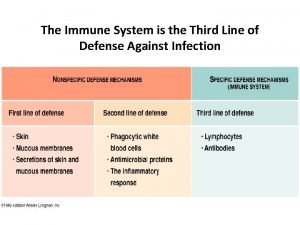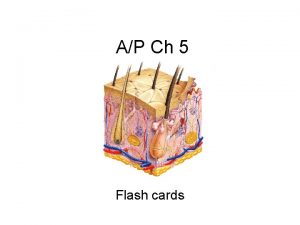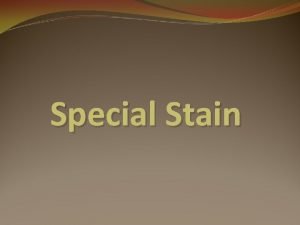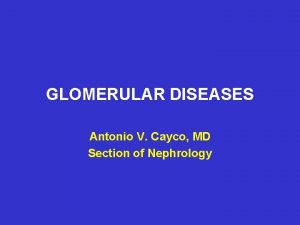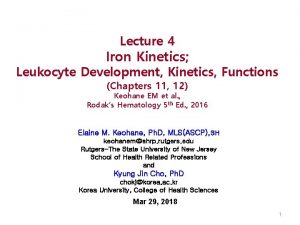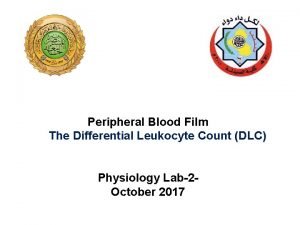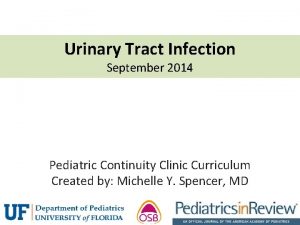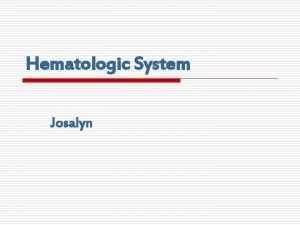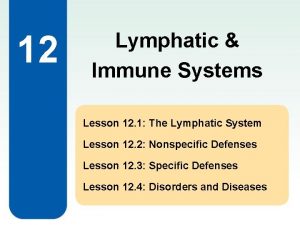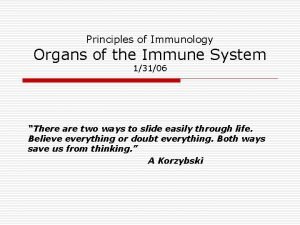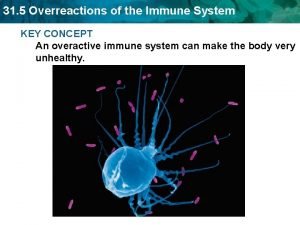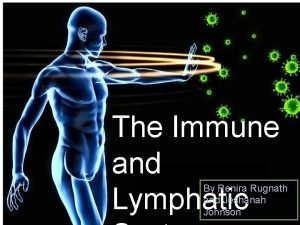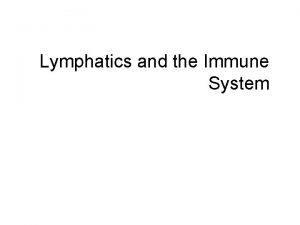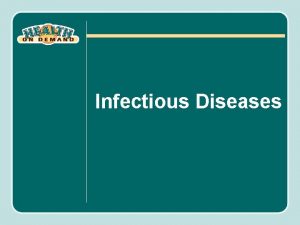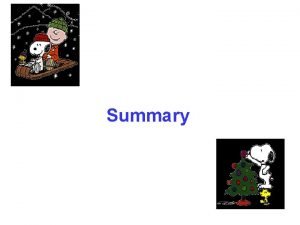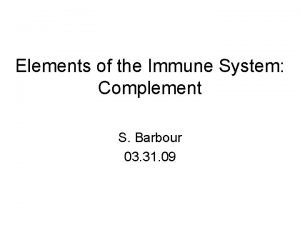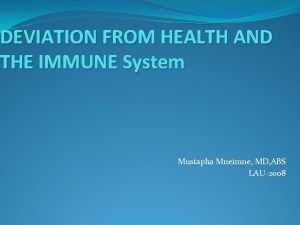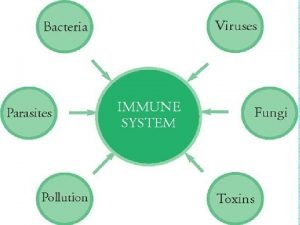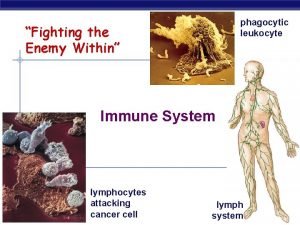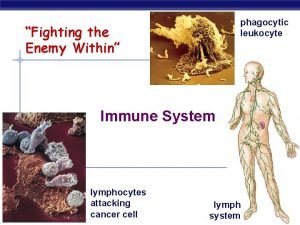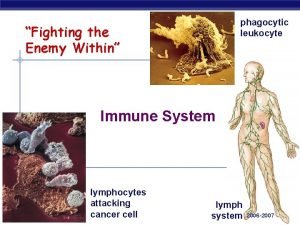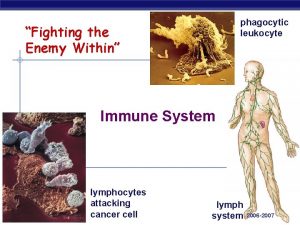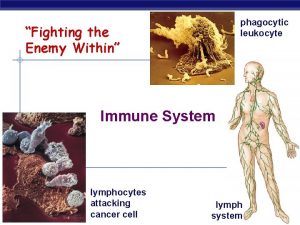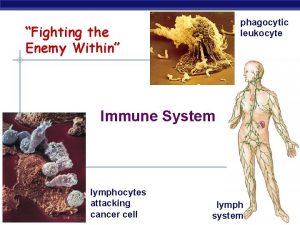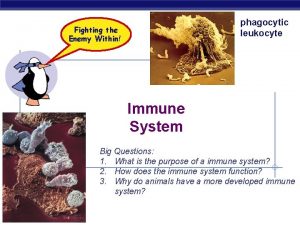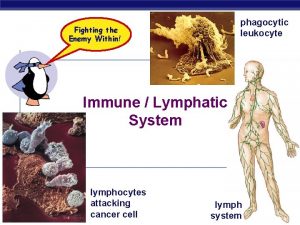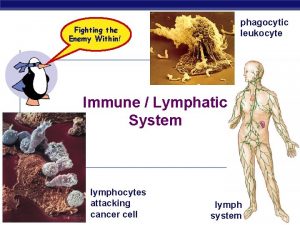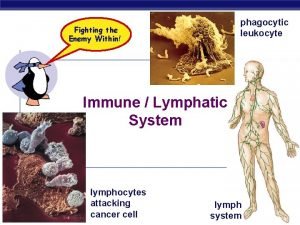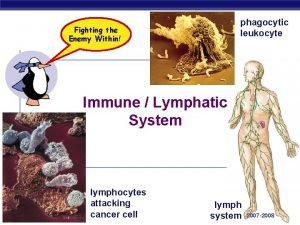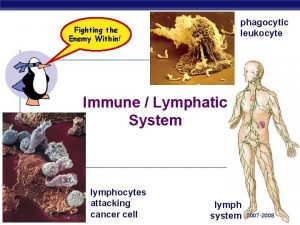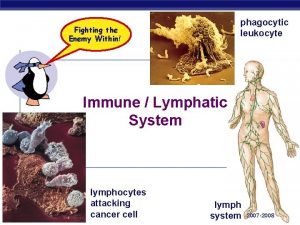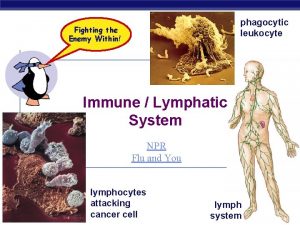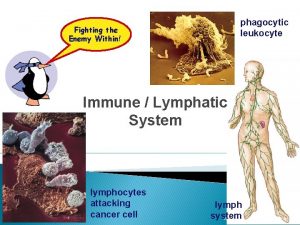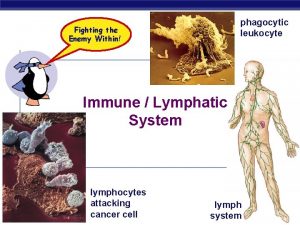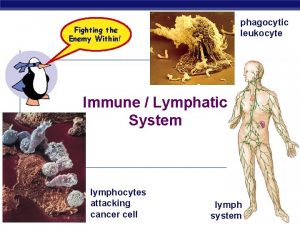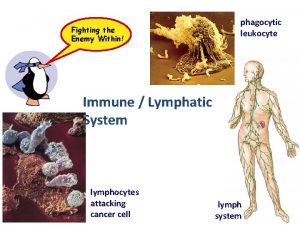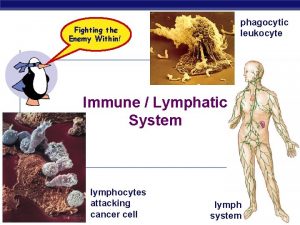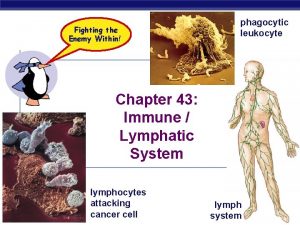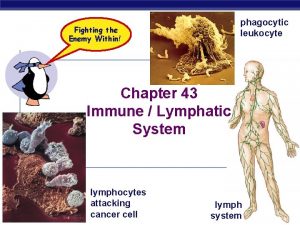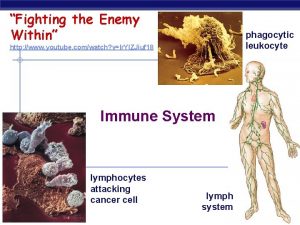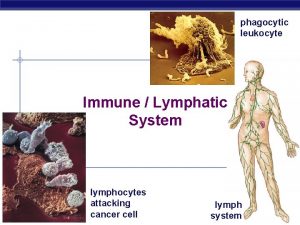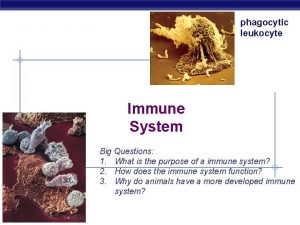phagocytic leukocyte Fighting the Enemy Within Immune System































- Slides: 31

phagocytic leukocyte “Fighting the Enemy Within” Immune System AP Biology lymphocytes attacking cancer cell lymph system 2006 -2007

Avenues of attack § Points of entry digestive system u respiratory system u urogenital tract u break in skin u § Pathways for attack circulatory system u lymph system u Regents Biology

Why an immune system? § __________________ u u lots of organisms want you for lunch! we are a tasty vitamin-packed meal § cells are packages of macromolecules § no cell wall u __________________ § ___________ w HIV, flu, cold, measles, chicken pox, SARS § ___________ w pneumonia, meningitis, tuberculosis § ___________ w yeast § ___________ w amoeba, Lyme disease, malaria u __________________ Regents Biology What’s for lunch? !

How are invaders recognized? § __________________ u ____________________________________ § “self” vs. “invader” one of your own cells disease-causing virus disease-causing bacteria antigens say: “I belong here” antigens say: “I am an invader” Regents Biology

Lines of defense § ______________ u broad, external defense § “walls & moats” u ______________ § ______________ u broad, internal defense § “patrolling soldiers” u ______________ § ______________ u specific, acquired immunity § “elite trained units” u ______________ Regents Biology § B & T cells

1 st line: Physical Barriers § non-specific defense § external barrier u ___________________ § ____________________ w respiratory system w digestive system w urinary system w genitals Regents Biology Lining of trachea: ciliated cells & mucus secreting cells

1 st line: Chemical barriers on skin § Skin & mucus membrane secretions u __________ § p. H 3 -5 u __________ § p. H 2 u __________ § washing action u __________ § traps microbes u __________ § anti-bacterial = “lick your wounds” u anti-microbial proteins § lysozyme w digests bacterial cell walls Regents Biology

2 nd: Generalist, broad range patrols § Patrolling ____________ u _________________ § ___________________ w surface name tag u phagocyte cells § __________ § “big eaters” Regents Biology Macrophage “eating” bacteria

Lymph system Production of white blood cells & traps “foreign” invaders lymph vessels (intertwined amongst blood vessels) Regents Biology 2 nd “circulatory” system lymph node

Phagocytes macrophage bacteria white blood cells that eat macrophage Regents Biology yeast

Why do injuries swell? § Inflammation u injured cells release chemical signals Pin or splinter § histamines w increases blood flow w brings more white blood cells to fight bacteria w brings more red blood cells & clotting factors to repair Regents Biology Bacteria Blood clot Swelling Chemical alarm signals Phagocytes Blood vessel

Fever § When a local response is not enough u full body response to infection u raises body temperature u higher temperature helps in defense § slows growth of germs § helps macrophages § speeds up repair of tissues Regents Biology

3 rd line: Lymphocytes § Specific defense u responds to specific invaders § recognizes specific foreign antigens § ___________________________ w ___________________________ Regents Biology B cell

B cells & antibodies § ______________ white blood cells that attack invaders in blood u mature in Bone marrow u § Plasma B cells u __________________ § Memory B cells u __________________ u can make antibodies quickly the next time § protects you from getting disease more than once Regents Biology

Antibodies § Proteins made by B cells that tag invaders in the blood so macrophages can eat them u tag says “this is an invader” gotcha! u _________________ Y Y Y Y Y Regents Biology Y Y YY Y Y B cells releasing antibodies invading germs tagged with antibodies macrophage eating tagged invaders

Y release antibodies patrol blood forever Y Y “reserves” Y YY Y Y Y Y 10 to 17 days Y Y Regents Biology Y Y Y Y Y Y memory B cells Y Y Y Y Y recognition B cells Y Y YY Y B cells Y Y (foreign antigen) Y Y Y invader Y Y B cells immune response Y

Vaccinations § ____________________________________ u rapid response if future exposure u § Most successful against viral diseases Regents Biology

Jonas Salk § Developed first vaccine u against polio April 12, 1955 Regents Biology 1914 – 1995

Polio epidemics 1994: Americas polio free Regents Biology

Protecting you from disease § Vaccinations u advantage § don’t get illness § long term immunity w produce antibodies for life § works against many viruses & bacteria § IMPORTANT PROTECTION u disadvantage § not possible against all invaders antibodies pass from mother to Breastfeeding baby in breast milk u mother’s milk gives baby antibodies & keeps baby healthy Regents Biology

What if the attacker gets past the B cells in the blood & infects some of your cells? You need trained assassins to kill off these infected cells! T AP Biology Attack of the Killer T cells! 2006 -2007

T cells § T cells mature in Thymus § Helper T cells u sounds the alarm for rest of immune system § Killer T cells u _______________ § Memory T cells u remembers invader & reacts against it again quickly Where’s that? Regents Biology

Thymus Regents Biology

Attack of the Killer T cells § _________________ T cell binds to invaded cell u secretes perforating protein u § punctures cell membrane of infected cell § cell bursts Killer T cell Cell membrane Perforin punctures cell membrane Regents Biology Vesicle Cell membrane Invaded cell

Immune response invader skin Y Y Y Regents Biology Y Y Y Y invaders infect cells Y Y invaders in blood skin

Protecting you from disease § _______________ u advantage § kill bacteria that have successfully invaded you w make you well after being sick u disadvantage § use only after sick § only good against bacteria § possible development of resistance by bacteria (if don’t use correctly) § can get sick again Regents Biology

Immune system malfunctions § _____________ u immune system attacks own cells § lupus w antibodies attack many different body cells § rheumatoid arthritis w antibodies causing damage to cartilage & bone § diabetes w beta-islet cells of pancreas attacked & destroyed § multiple sclerosis w T cells attack myelin sheath of Regents Biology brain & spinal cord nerves

Immune system malfunctions § Allergies u __________________ § allergens w proteins on pollen w proteins from dust mites w proteins in animal saliva § body mistakenly thinks they are attackers Regents Biology

Diseases of the immune system § HIV: Human Immunodeficiency Virus _____________ u helper T cells can’t activate rest of immune system u § body doesn’t hear the alarm § AIDS: Acquired Immuno. Deficiency Syndrome __________________________ u death usually from other invading diseases or cancer u Regents Biology

How to protect yourself… Regents Biology

It’s safe to ask Questions! AP Biology 2006 -2007
 Primary immune response and secondary immune response
Primary immune response and secondary immune response Immune system lines of defense
Immune system lines of defense Phagocytic cells that occupy the epidermis are called
Phagocytic cells that occupy the epidermis are called Cytochemical stains for leukemia ppt
Cytochemical stains for leukemia ppt Size of wbc
Size of wbc Vcayco
Vcayco Abbas et al
Abbas et al Dlc physiology
Dlc physiology Leukocyte esterase
Leukocyte esterase Leukocyte removal filter
Leukocyte removal filter What is the third line of defense in the immune system
What is the third line of defense in the immune system Flow chart
Flow chart Third line of defense immune system
Third line of defense immune system Innate immunity first line of defense
Innate immunity first line of defense Chapter 35 immune system and disease
Chapter 35 immune system and disease What is the third line of defense in the immune system
What is the third line of defense in the immune system Ap biology immune system
Ap biology immune system Lesson 12.1 lymphatic ducts and vessels
Lesson 12.1 lymphatic ducts and vessels Lesson 12 blood and immune system
Lesson 12 blood and immune system Oobean
Oobean Immunity assignment slideshare
Immunity assignment slideshare Overreactions of the immune system
Overreactions of the immune system Lymphatic vs immune system
Lymphatic vs immune system Lymphatic vs immune system
Lymphatic vs immune system Defination of immune system
Defination of immune system Main function of the immune system
Main function of the immune system Tonsil
Tonsil Thymus
Thymus Mac immune system
Mac immune system Thalassemia facies
Thalassemia facies 1what's the purpose of the body's immune system?
1what's the purpose of the body's immune system? Israeli fighting system
Israeli fighting system

